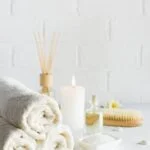Aromatherapy has gained immense popularity in recent years as people seek natural and holistic approaches to improve their well-being. One of the most commonly used essential oils in aromatherapy is lavender oil, prized for its soothing and calming properties. In this article, we will explore how to effectively use lavender oil for aromatherapy to promote relaxation, reduce stress, and enhance overall mental and physical health.
Aromatherapy is a practice that involves using essential oils derived from plants to promote physical and psychological well-being. These plant extracts contain powerful compounds that can positively impact our mood, emotions, and even our physical health when used properly. Lavender oil has become particularly popular in aromatherapy due to its versatility and numerous benefits.
Lavender oil is renowned for its ability to induce relaxation, reduce anxiety, and promote better sleep. It can also help alleviate headaches, soothe skin conditions like eczema and acne, and provide relief from respiratory issues such as congestion or allergies. With its gentle yet potent properties, lavender oil has become a staple in many households seeking natural remedies for common ailments.
As more people turn to lavender oil for its remarkable therapeutic benefits, it is important to understand how to choose the right type of lavender oil and use it effectively. In the following sections of this article, we will delve into factors influencing the quality of lavender oil, explore the science behind its effectiveness in aromatherapy, discuss different methods of incorporating it into your daily routine, share DIY recipes for customized blends, and provide precautions for safe usage.
By incorporating lavender oil into your aromatherapy practice, you can experience a range of benefits for your mind, body, and spirit. Whether you are looking to unwind after a long day or seeking relief from certain conditions or simply wanting to create a peaceful atmosphere at home or work – lavender oil can be your trusted companion on this aromatic journey towards improved well-being.
Choosing the Right Lavender Oil for Aromatherapy
When it comes to using lavender oil for aromatherapy, selecting the right type of oil is essential to ensure maximum effectiveness and enjoyment. With so many options available in the market, it can be overwhelming to determine which lavender oil is of high quality. Here are some tips to help you choose the right lavender oil for your aromatherapy needs.
Firstly, it’s important to understand that there are several different species of lavender, each with its own unique aroma and therapeutic properties. The most commonly used species for aromatherapy is Lavandula angustifolia or True Lavender. This type of lavender oil is known for its calming and relaxing effects.
When purchasing lavender oil, look for ones that are labeled as 100% pure essential oil. This ensures that the oil has not been diluted or contaminated with other substances. It’s also beneficial to choose oils that have been produced through steam distillation, as this method helps retain the natural properties and fragrance of lavender.
Another factor to consider is where the lavender was grown and harvested. Lavender plants grown in regions with favorable climates, such as France or Bulgaria, tend to produce higher quality oils compared to those grown in less ideal conditions.
Lastly, pay attention to the color and scent of the lavender oil. A high-quality oil should have a pale yellow or colorless appearance. The aroma should be fresh, floral, and balanced – not overly sweet or artificial smelling.
By taking these factors into consideration when choosing your lavender oil, you can ensure that you are getting a high-quality product that will enhance your aromatherapy practice and provide you with all the benefits that lavender has to offer.
Understanding the Science Behind Lavender Oil in Aromatherapy
Aromatherapy has gained immense popularity in recent years for its various therapeutic benefits. One of the most widely used essential oils in aromatherapy is lavender oil. In this section, we will delve into the science behind lavender oil and how it contributes to the effectiveness of aromatherapy.
Lavender oil contains several chemical compounds that are responsible for its soothing and relaxing properties. The main components of lavender oil include linalool, linalyl acetate, lavandulol, and lavandulyl acetate. These compounds have been found to have anti-inflammatory, antimicrobial, sedative, and analgesic effects.
When inhaled or applied topically, these compounds interact with the olfactory system and the skin receptors to induce a state of relaxation and calmness. Studies have shown that inhaling lavender oil can reduce anxiety levels by influencing the activity of neurotransmitters in the brain, such as serotonin and gamma-aminobutyric acid (GABA). This helps promote a sense of well-being and stress relief.
Additionally, lavender oil has been found to affect the autonomic nervous system, which regulates vital functions like heart rate and blood pressure. Inhalation of lavender oil has been shown to slow down heart rate and lower blood pressure, further contributing to its relaxation benefits.
Understanding the science behind lavender oil in aromatherapy not only enhances our knowledge but also validates its efficacy as a natural remedy for stress relief and relaxation. Armed with this knowledge, individuals can confidently incorporate lavender oil into their daily lives to experience its therapeutic effects firsthand.
Different Methods of Using Lavender Oil for Aromatherapy
When it comes to enjoying the benefits of lavender oil for aromatherapy, there are several different methods to choose from. Incorporating lavender oil into your daily routine can help promote relaxation, reduce stress, and improve overall well-being. In this section, we will explore the various ways you can use lavender oil for aromatherapy, including inhalation, topical application, and diffusion.
Inhalation is one of the most common methods of using lavender oil for aromatherapy. The act of inhaling the scent of lavender oil has been shown to have a calming effect on the nervous system, reducing anxiety and promoting relaxation. There are different inhalation techniques you can try, such as steam inhalation or using a diffuser.
Steam inhalation involves adding a few drops of lavender oil to a bowl of hot water and placing your face over the bowl, covering your head with a towel to trap in the steam. Inhaling deeply for a few minutes can help relieve congestion and clear your mind. Another option is to use a diffuser, which disperses the scent of lavender oil throughout a room. This allows you to enjoy the benefits of aromatherapy without direct contact with the oil.
Topical application is another effective way to use lavender oil in aromatherapy. However, it’s important to dilute lavender oil with a carrier oil before applying it directly to your skin. Carrier oils such as jojoba or coconut oil help prevent skin irritation and allow for better absorption of essential oils. You can create your own massage blend by combining a few drops of lavender oil with your chosen carrier oil and gently massaging it onto your skin.
| Method | Description |
|---|---|
| Inhalation | Inhaling the scent of lavender oil for relaxation and stress relief, using techniques like steam inhalation or diffusers. |
| Topical Application | Diluting lavender oil with a carrier oil and applying it to the skin for soothing effects and promoting sleep. |
| Diffusion | Using a diffuser to disperse the scent of lavender oil throughout a room, creating a calming atmosphere. |
Inhalation Techniques
When it comes to using lavender oil for aromatherapy, inhalation techniques are an effective way to maximize its benefits. Inhaling the soothing scent of lavender can promote relaxation and relieve stress, making it a popular choice for those looking to improve their well-being. There are several different methods of inhalation that can be used to incorporate lavender oil into your daily routine.
One method of inhaling lavender oil is through steam inhalation. To do this, fill a bowl with hot water and add a few drops of lavender oil. Lean over the bowl and cover your head with a towel to trap the steam.
Breathe deeply and slowly for about 5-10 minutes, allowing the aromatic molecules from the lavender oil to enter your respiratory system and provide therapeutic effects. Steam inhalation with lavender oil can help soothe respiratory conditions, relieve congestion, and enhance relaxation.
Another popular way to enjoy the benefits of lavender oil is through using a diffuser. A diffuser is a device that disperses essential oils into the air in the form of a fine mist or vapor.
Simply add a few drops of lavender oil to your diffuser along with water, turn it on, and allow the aroma to fill the room. Diffusing lavender oil in this way not only creates a calming atmosphere, but it also helps purify the air and reduce airborne bacteria.
In addition to steam inhalation and diffusion, there are other methods you can explore for using lavender oil for inhalation purposes. These include adding a drop or two of lavender oil to a tissue or cotton ball and inhaling directly from it throughout the day or using an inhaler tube filled with cotton soaked in lavender oil for on-the-go aromatherapy.
Incorporating inhalation techniques into your aromatherapy practice with lavender oil is an excellent way to experience its numerous benefits. Whether you choose to inhale the aroma through steam inhalation, diffusion, or other methods, the soothing scent of lavender can have a profound impact on your relaxation and overall well-being.
Topical Application
When it comes to incorporating lavender oil into your aromatherapy practice, topical application is an effective and popular method. However, it is important to ensure safe usage and avoid any potential skin irritation or adverse reactions. In this section, we will provide guidelines for diluting lavender oil with a carrier oil and explain the benefits of using lavender oil topically.
Firstly, it is crucial to always dilute lavender oil before applying it directly to the skin. Undiluted essential oils can be too strong and may cause skin irritation or sensitization. The general rule of thumb is to use a 2% dilution ratio, which means adding approximately 12 drops of lavender oil per ounce of carrier oil. Common carrier oils include almond oil, jojoba oil, coconut oil, or olive oil.
Diluting lavender oil not only helps protect your skin but also allows for better absorption. When applied topically, lavender oil has numerous potential benefits such as soothing skin conditions like acne or eczema, reducing inflammation, and promoting relaxation. Additionally, the calming aroma of lavender can help improve sleep quality when used as part of a nighttime routine.
To use lavender oil topically, simply mix the desired amount of diluted oil in your palm and apply it to the desired area using gentle massage motions. It is essential to perform a patch test on a small area of your skin before applying it more extensively. This will help you check for any adverse reactions or sensitivities.
| Benefits of Topical Application | Guidelines for Diluting Lavender Oil |
|---|---|
| – Soothes skin conditions like acne or eczema | – Use a 2% dilution ratio (approximately 12 drops of lavender oil per ounce of carrier oil) |
| – Reduces inflammation | – Choose a carrier oil such as almond oil, jojoba oil, coconut oil, or olive oil |
| – Promotes relaxation and better sleep quality | – Perform a patch test on a small area of skin before regular application |
Creating DIY Lavender Oil Blends for Aromatherapy
Lavender oil is an incredibly versatile essential oil that can be used on its own or blended with other oils to enhance the benefits of aromatherapy. Creating your own personalized lavender oil blends allows you to tailor your aromatherapy experience to meet your specific needs and preferences. Whether you are looking to promote better sleep, relieve headaches, or simply create a calming atmosphere, here are some easy-to-follow recipes for creating DIY lavender oil blends.
Lavender and Chamomile Relaxation Blend
This blend combines the soothing properties of lavender and chamomile to promote relaxation and stress relief. To create this blend, combine 5 drops of lavender oil with 3 drops of chamomile oil in a diffuser or essential oil burner filled with water. Allow the fragrance to fill the room and breathe deeply to experience a sense of calm and tranquility.
Lavender and Peppermint Headache Relief Blend
For those suffering from headaches or migraines, this blend can provide much-needed relief. Combine 4 drops of lavender oil with 2 drops of peppermint oil and dilute in a carrier oil such as coconut or almond oil. Gently massage the blend onto your temples and forehead using circular motions. The cooling sensation of peppermint combined with the calming properties of lavender can help alleviate tension and ease headache symptoms.
Lavender and Bergamot Sleep Aid Blend
If you struggle with insomnia or have difficulty falling asleep, this blend can help promote better sleep quality. In a small spray bottle, combine 10 drops of lavender oil with 5 drops of bergamot oil and fill the rest with distilled water.
Shake well before use and lightly mist your pillow, bedsheets, or bedroom environment before going to bed. The soothing aroma of lavender combined with the uplifting scent of bergamot can create a relaxing atmosphere and promote a restful sleep.
Lavender and Eucalyptus Respiratory Blend
For those with respiratory issues or congestion, this blend can help clear the airways and promote easier breathing. In a bowl of hot water, add 3 drops of lavender oil and 2 drops of eucalyptus oil.
Lean over the bowl, cover your head with a towel, and inhale deeply for several minutes to allow the steam to open up your nasal passages. The anti-inflammatory properties of lavender combined with the decongestant properties of eucalyptus can provide relief from respiratory discomfort.
Creating your own DIY lavender oil blends for aromatherapy is not only a fun and creative process but also allows you to personalize your aromatherapy experience to best suit your needs. Experiment with different combinations and ratios of lavender oil with other essential oils to find blends that resonate with you.
Remember to always dilute essential oils properly before applying topically and discontinue use if any adverse reactions occur. Embrace the calming and therapeutic effects of these personalized lavender oil blends in your daily aromatherapy practice.
Precautions and Potential Side Effects of Using Lavender Oil in Aromatherapy
Potential Allergic Reactions and Sensitivities
While lavender oil is generally considered safe for most individuals, it is important to be aware of potential allergic reactions or sensitivities. Some individuals may experience skin irritation, redness, or itching upon direct contact with undiluted lavender oil. It is highly recommended to perform a patch test before applying lavender oil topically.
This can be done by applying a small amount of diluted lavender oil to a small area of the skin and monitoring for any adverse reactions over the next 24 hours. If any signs of irritation occur, discontinue use immediately.
Safety Precautions and Guidelines
When using lavender oil in aromatherapy, it is crucial to follow safety precautions and guidelines. Pregnant women should exercise caution and consult with their healthcare provider before incorporating lavender oil into their routine, as some sources suggest that it may have uterine-stimulating effects. Additionally, children and infants have more sensitive skin than adults and therefore require extra dilution when applying lavender oil topically. It is advisable to consult with a pediatrician before using lavender oil on children.
Proper Storage and Handling
To ensure the longevity and effectiveness of your lavender oil for aromatherapy, proper storage and handling are essential. Keep the bottle tightly sealed when not in use and store it in a cool, dark place away from direct sunlight, heat, or moisture. Exposure to these elements can degrade the quality of the oil over time. Always check the expiration date on the bottle and discard any expired or oxidized oils.
By adhering to these precautions and guidelines, you can safely enjoy the benefits of using lavender oil for aromatherapy without any potential side effects or risks. Remember to always consult with a healthcare professional if you have any concerns or questions regarding the use of lavender oil in your specific circumstances.
Conclusion
In conclusion, incorporating lavender oil into your aromatherapy practice can provide numerous benefits for both your physical and mental well-being. Throughout this article, we have explored the concept of aromatherapy and highlighted the growing popularity of using lavender oil for its therapeutic properties. We have discussed the different types of lavender oil available in the market and provided tips on selecting a high-quality oil for maximum effectiveness.
Furthermore, we have delved into the science behind lavender oil in aromatherapy, explaining how its chemical compounds interact with the brain to promote relaxation and stress relief. We have also discussed various methods of using lavender oil for aromatherapy, including inhalation techniques and topical application.
By inhaling lavender oil through steam inhalation or using a diffuser, you can maximize its benefits for relaxation and stress relief. Topical application is another effective method, but it is important to dilute the lavender oil with a carrier oil to ensure safety.
Additionally, we have shared DIY recipes for creating personalized lavender oil blends, whether it be for promoting better sleep or relieving headaches. However, it is essential to be aware of potential precautions and side effects when using lavender oil in aromatherapy.
Incorporating lavender oil into your daily routine can help create a calming and therapeutic environment. Whether it’s through inhalation or topical application, embracing the soothing effects of lavender oil can enhance your overall well-being. So why not start incorporating this versatile essential oil into your aromatherapy practice today?
Frequently Asked Questions
Can you apply lavender essential oil directly?
Lavender essential oil is generally safe to apply directly to the skin, however, it is recommended to dilute it with a carrier oil before use. This helps prevent any potential skin irritation or sensitivity that some individuals may experience.
To dilute lavender oil, simply mix a few drops of the essential oil with a suitable carrier oil such as coconut oil or sweet almond oil. Once diluted, you can apply it topically to areas like temples, wrists, or the back of your neck for various benefits such as relaxation or soothing minor skin irritations.
Where do you put lavender oil for calming?
Lavender oil is widely known for its calming properties and can be used in several ways to promote relaxation. One common method is by using a diffuser or aromatherapy inhaler where you add a few drops of lavender oil and let the scent permeate through the air. This allows you to benefit from its calming effects by inhaling the aroma.
Alternatively, you can create a homemade linen spray by combining lavender essential oil with distilled water in a spray bottle and spritzing it on your pillowcases or bedding before sleep. Additionally, you may consider adding a few drops of lavender essential oil to your bathwater for a soothing and calming bathing experience.
How do you use lavender oil for smell?
When using lavender oil for its pleasant smell, there are several methods to enjoy its fragrance. One option is to use an aromatherapy diffuser where you add a few drops of lavender essential oil along with water and allow the diffuser to disperse the scent into your living space. Another way is to create scented sachets by placing dried lavender flowers inside small fabric pouches along with a few drops of lavender essential oil.
These sachets can then be placed in drawers, closets, or tucked under your pillow for their delightful scent. Moreover, you can make your own scented body products such as lotions or massage oils by adding a small amount of lavender essential oil for its aromatic qualities.

Are you looking for a natural way to improve your health and wellbeing?
If so, aromatherapy may be the answer for you.





